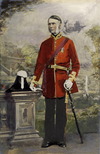SIMONET (Simmonet) D’ABERGEMONT, JACQUES, forge master and partner in the Saint-Maurice ironworks; b. in Dompierre, in the diocese of Langres, France, son of Jean-Baptiste Simonet and Élisabeth Bériault; m. first, in France, Marie Foissey, and secondly, at Trois-Rivières, Geneviève, daughter of Lambert Boucher* de Grandpré and widow of Charles Hertel de Chambly; buried 21 May 1742 in Trois-Rivières.
Nothing positive is known of Jacques Simonet d’Abergemont’s activities in France prior to his arrival in the colony in 1736. A concern with the iron industry was common in Champagne, the area of his birth, in the 18th century, when members of the French gentry or civil service were often deeply involved in this industry.
Maurepas, the minister of Marine, and Gilles Hocquart*, New France’s intendant, were primarily responsible for recruiting Simonet to aid in developing the Saint-Maurice ironworks. Both believed that a second forge master, to assist Pierre-François Olivier* de Vézin, the French forge master who had arrived in 1735, would accelerate the establishment of the industry. Simonet, in agreeing to move to New France, made it a condition that he be allowed to participate in the company to be formed; he became a partner of Vézin and the Canadians François-Etienne Cugnet, Ignace Gamelin* the younger, and Thomas-Jacques Taschereau. As well, he was, like Vézin, to receive an annual salary which was to be considered an expense of the company and not taken from profits. Only in Vézin’s absence did he act as forge master; his main task was to recruit experienced workers from France, and in this he fulfilled his duties well, so much so that French forge masters complained to Maurepas that he was stealing away their workers, including some who were deeply in debt to them. Like Vézin, Simonet was not above taking advantage of his position: in 1739, at the expense of the government, he brought a son born of his first marriage, Jean-Baptiste, to the colony and employed him at the ironworks. Both father and son, however, appear to have been well thought of by local officials.
In 1739–40 Vézin was in France and Simonet was the de facto forge master, albeit with reduced powers; in effect, the supplying of materials for the ironworks, both for construction and for the maintenance of the workers, was put into the hands of a subcontractor. During Vézin’s absence attempts were made to set the affairs of the company in better order, its financial position being a cause for great concern. Simonet and Vézin were put on a piece-work stipend, the total of which, however, could not exceed their old annual salary; in Simonet’s case, this had been 1,500 livres per year, plus room and board of a rather luxurious nature.
Disputes among the partners were constant in late 1741 and the company went bankrupt that year. Simonet took the side of his metropolitan colleague, Vézin, accused of undertakings too ambitious for the resources available, but he never suffered as did Vézin from the barbs of his Canadian associates. Amid the ironworks’ difficulties, Simonet made a serious offer to Maurepas to take over the operation of the industry in his own name; he was unable to prove that he had the capital required and his considerate offer was refused. He died soon after. In 1743 the ironworks had to be removed from private hands and reunited to the king’s domain; at this time Simonet’s indebtedness to the crown, and that of his partners, was cancelled.
Jean-Baptiste Simonet, having a good reputation, had replaced Vézin as forge master in 1741 at the same time as Hocquart made Guillaume Estèbe* his subdelegate to administer the ironworks. The confidence of Hocquart and Maurepas was quickly put to the test: Jean-Baptiste diverted both cash and products to his own pocket. Hocquart arranged for his return to France in 1742.
Jacques Simonet cannot, of course, be held responsible for the behaviour of his son. But, although he had greater probity, he had his own self-seeking tendencies. After the debacle of the bankruptcy, he was unsparing in his criticisms of his ex-partners. While a partner in the Saint-Maurice ironworks he had flirted with the possibility of assisting Louis Lepage de Sainte-Claire in establishing an iron industry on Lepage’s lands in Terrebonne. Like many others who came to the colony with a specialized knowledge he attempted, though in his case with little success, to acquire all he could, behaviour typical of a metropolitan and even, it must be added, of the citizens of New France.
Cameron Nish and Claude Richard
ANQ, NF, Coll. de pièces jud. et not., 1176. PAC Report, 1904, app.K, passim. Dictionnaire national des Canadiens français (1608–1760) (2v., Montréal, 1958), II. Tanguay, Dictionnaire. Sulte, Mélanges historiques (Malchelosse), VI. Albert Tessier, Les forges Saint-Maurice, 1729–1883 (Trois-Rivières, 1952).
© 1974–2024 University of Toronto/Université Laval
Cite This Article
Cameron Nish and Claude Richard, “SIMONET D’ABERGEMONT, JACQUES,” in Dictionary of Canadian Biography, vol. 3, University of Toronto/Université Laval, 2003–, accessed April 20, 2024, http://www.biographi.ca/en/bio/simonet_d_abergemont_jacques_3E.html.
The citation above shows the format for footnotes and endnotes according to the Chicago manual of style (16th edition). Information to be used in other citation formats:
| Permalink: | http://www.biographi.ca/en/bio/simonet_d_abergemont_jacques_3E.html |
| Author of Article: | Cameron Nish and Claude Richard |
| Title of Article: | SIMONET D’ABERGEMONT, JACQUES |
| Publication Name: | Dictionary of Canadian Biography, vol. 3 |
| Publisher: | University of Toronto/Université Laval |
| Year of publication: | 1974 |
| Year of revision: | 1974 |
| Access Date: | April 20, 2024 |







